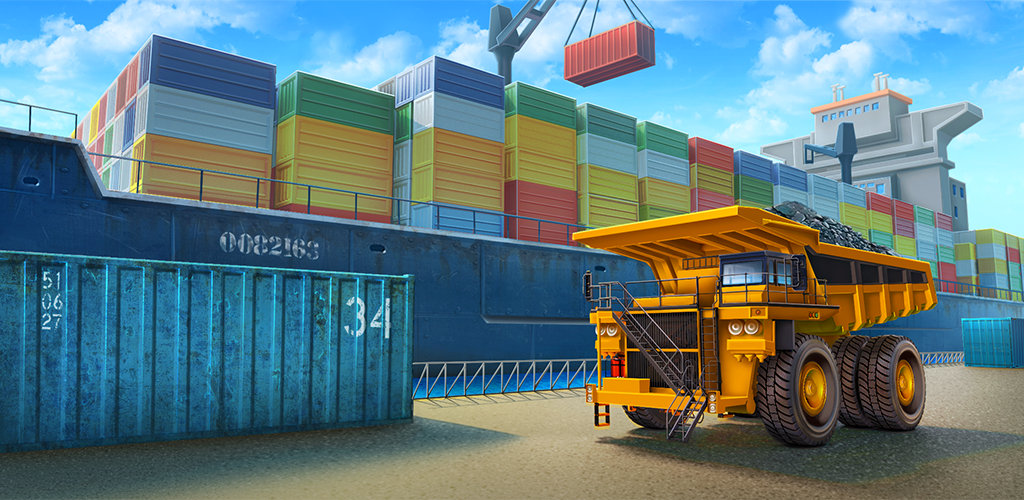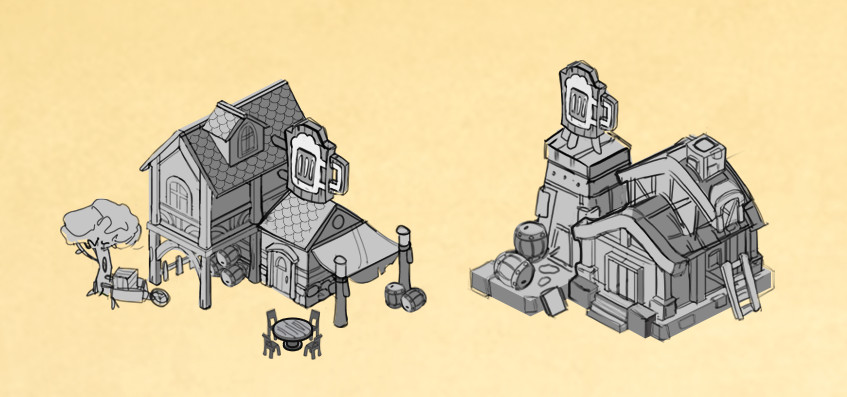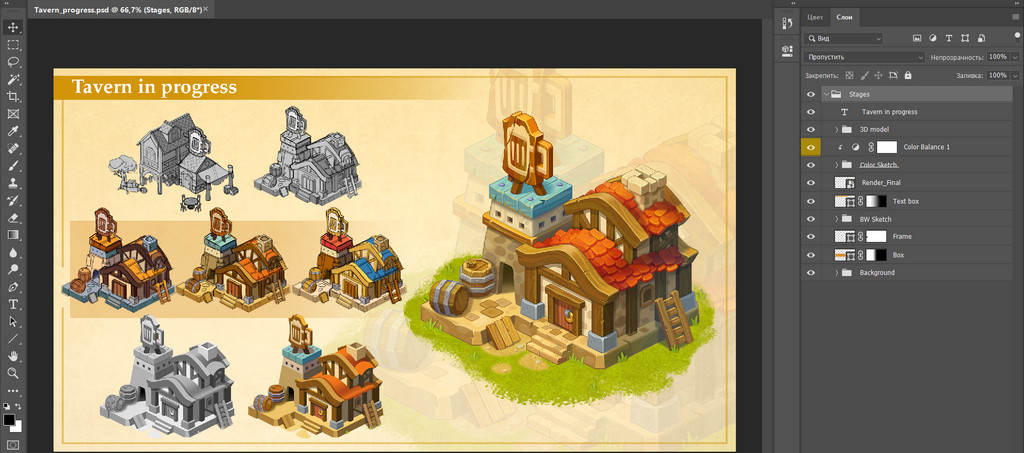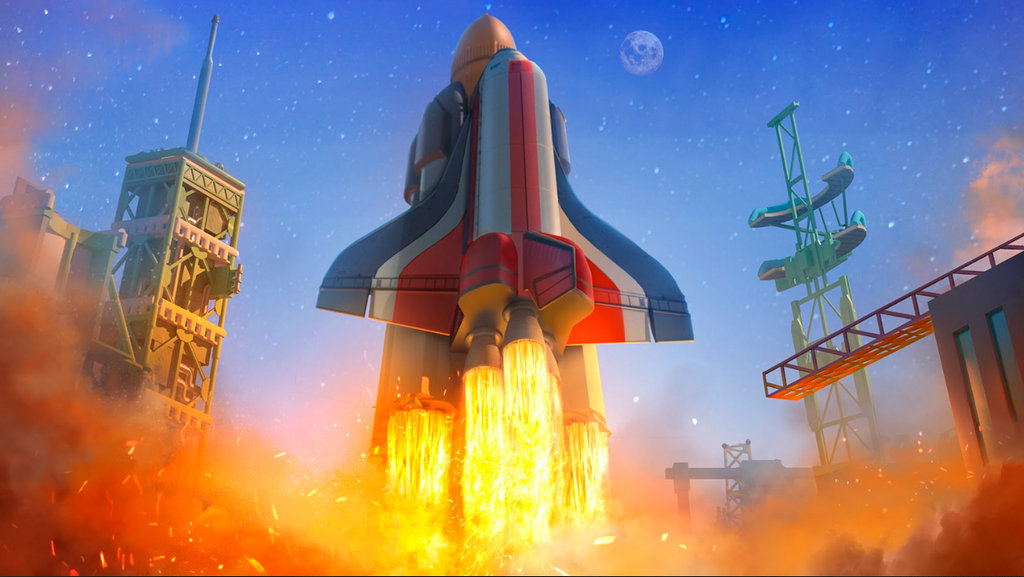Are you on the verge of a game release but missing a few elements for the initial launch? Has your project been in the works for a while, and constant updates require a significant amount of art? Or does your project only exist on paper (or in your mind), and you need help determining exactly what art you need? No need to panic! In each of these situations (and many others), the art team at Allcorrect will be happy to assist you.
 Ordering art is no more difficult than ordering freight transportation!
Ordering art is no more difficult than ordering freight transportation!
Art Department Staff
A whole team will work on any specific project. This team includes:
• Art Director. Possesses a deep understanding of various art directions and styles. Ensures the overall quality of each project and shapes the project’s vision.
• Art Lead. Has an art background, understands the client’s vision, and guides and provides feedback to the artists. The art lead is responsible for the artistic component of the project and quality control.
• Artists. These work with us on both a permanent basis and a freelance model, which allows us to meet a wider range of customer needs and attract the best specialists for each specific task.
• Project Manager. Organizes the project workflow, creates and monitors the schedule, communicates with the client, and takes action if something deviates from the plan. Responsible for completing projects on time and within budget.
In this scheme, the art director serves as the central core of the department, with the art lead and artists reporting to them. Artists work directly under the guidance of the art lead. The project manager monitors project execution and ensures communication between the art department, the client, and other company departments.
 Our teams have to be agile and resourceful, just like these space troopers.
Our teams have to be agile and resourceful, just like these space troopers.
In addition to the production team, the art department also involves sales managers, account managers, quality management system (QMS) specialists, and vendor managers who are responsible for sourcing and assessing artists’ skills. Our colleagues help us establish a convenient and transparent process and respond appropriately to the challenges that arise during projects.
First Cost Estimation
Communication with the client, from the initial contact to the actual order, is facilitated by a sales manager or an account manager. Our colleagues will gather the necessary information for the initial estimate from you (details of the initial brief are further elaborated in the article “Brief for Game Art Development”) and pass it on to the project manager. The project manager and the art lead will review the materials and ask clarifying questions as needed.
After receiving the answers, we will suggest scheduling a call with the team to discuss the nuances of the work. This is necessary to better understand the client’s vision, clarify the reference material, determine the target workflow, and simply to get acquainted and establish contact. After the call, the project manager, art lead, and account manager will fill out a detailed art brief (which includes not only administrative information such as communication methods, general information about the client and the project, but also important art-related details such as references, stylistics, quality criteria, etc.) and prepare the final estimate. The sales manager or account manager will send these materials to the client and be ready to answer any questions that may arise.
 Our sales and account managers document all agreements, just like this anime character.
Our sales and account managers document all agreements, just like this anime character.
Upon client request, we can perform a small test task. This is preferably a real task, so if the project requires developing/drawing icons, it’s best to create one or a couple of such icons for the test. The test task is an excellent way to test the specifications and pipeline. Usually, after the test, we can determine many nuances that are not always possible to identify at the preliminary stage. This could include things like the behavior of reflections on materials and other minor yet crucial details for the final image. In terms of pipelines, we might find that we need to add a preliminary review stage, which can significantly reduce the number of potential revisions and overall production time for the asset.
The approximate time frame for this stage is around 2-3 days and includes gathering additional information, conducting a call, and preparing the estimate.
Workflow Process
Between signing the contract and starting the task, we conduct a Pre-Art Analysis. During this phase, the project manager and other team members (sales manager, account manager, and enthusiastic colleagues under the project manager’s guidance) conduct research on the source material, gather more references related to the game, visual materials, lore, and other information that will help us better understand the project we’ll be working on. The project manager compiles this material and shares it with the art lead for review or edits. The resulting document is then used as part of the task’s specifications.
After receiving detailed information about the specific task, we usually conduct a kickoff call with the client’s team for a better understanding of the task and to fill in the specifications, clarify missing information, and determine a detailed pipeline.
 Our created character, Gino, enjoys conversations—a skill necessary for project managers!
Our created character, Gino, enjoys conversations—a skill necessary for project managers!
After the Pre-Art Analysis, we compile all the available information into a brief, which clarifies requirements, vision, and references, and solidifies technical aspects of the work. The brief includes all significant details of the asset: style, color palette, lighting direction, and so on. In the technical requirements, it is important to specify the requirements for the final file, covering general aspects such as file size, and the more complex nuances of each type of graphic. For a 2D asset, these nuances may involve specific layer breakdowns for subsequent animation, while for a 3D character, there may be requirements regarding polygon count.
Together with the art lead, we also assemble the project team (based on the results of a specialized test task) and define our internal workflow. We build our internal processes around the existing client’s process (or offer our own solution if necessary) to ensure the most comfortable collaboration experience.
With the ready brief, team, and detailed workflow, we conduct an internal kickoff call for the team and officially prepare for the launch! :)
By having a well-established process, we can ensure that project work proceeds smoothly—that intermediate results are delivered on schedule, feedback is timely, and the work steadily progresses toward completion.
The internal workflow resembles a typical approval pipeline with the client—the artist submits an intermediate version, the art lead reviews and provides feedback if necessary, and the project manager monitors the process and deadline adherence.
The approval process with the client typically involves the project manager presenting the intermediate result to the client for review, the art lead or another approving party checking and providing feedback, and the project manager taking the feedback and communicating it to the art lead for implementation.
During the process, all feedback from the client is analyzed in terms of compliance with the brief. If it turns out that our work does not meet the requirements and we receive a revision request, the project manager and QMS manager analyze the feedback and ensure necessary amendments are made to the brief, attention is brought to the issue for the artists and art lead, and the problem is mitigated for future deliveries.
After the acceptance of the visual and technical aspects of the project, we send an invoice to the client and conduct an internal and external post-mortem analysis. We review the issues that arose and find solutions, document additional specifications discovered during the work process, and request overall feedback from the client, ensuring that future projects run smoothly and with updated data.
Approximate timing:
Kickoff call: ASAP upon receiving the task.
Team assembly, brief creation, and workflow development: around one week.
Feedback analysis: during the project and upon completion.
Post-mortem: after project completion (usually a few days after issuing the invoice).


Acceptance Stages
The acceptance stages depend on the type of graphics required, but in general, they can be summarized as follows. We will use 2D art as an example:
1. Concept art. Based on selected references, asset concepts are developed, usually in multiple variations, using black-and-white graphics and without detailed rendering.

2. Colored sketch. Several color variations are prepared for the selected sketch from the previous stage. These are generally flat color fills without shading or volume rendering.

3. Final render. The asset with the chosen color scheme is refined to the final quality according to the references. This stage includes finalizing shadows, reflections, highlights, and adjusting lighting.

Preparing source files (slicing layers, naming layers, etc.).


Work Result
As a result of our work, the client receives a ready-to-upload object for the engine or publication, which can then be used in game, for stores, or for presentation to investors, etc. The object corresponds to the references specified at the beginning of the project and is executed according to the compiled brief. Additionally, after several projects, we can prepare a Project Bible that covers all the types of objects we have worked on, including examples and quality criteria.
 We are ready to blast off with new projects!
We are ready to blast off with new projects!
In summary, art outsourcing significantly reduces the time required for graphics production and saves internal resources. The client only needs to review intermediate results, make adjustments if necessary, and approve the final result. We handle the majority of the work, including brief compilation, art direction, and other production matters.
You can view our portfolio here.
If you need an art production cost estimate or consultation, please contact us here.
If you are an artist and would like to collaborate with us, please fill out the form.



